Salmon Farming in Scotland
Farmed Atlantic salmon is Scotland's and the UK’s largest food export. This briefing provides information on Scotland's production and export of salmon and the associated jobs. It discusses issues around farmed salmon health, including sea lice. It sets out the regulatory regime salmon producers in Scotland must work within.
Executive Summary
Aquaculture is the farming of aquatic animals and plants in fresh, brackish or marine water environments. There is likely to be increasing demand for farmed fish given the predicted increase in world population and environmental pressures on land.
In Scotland, finfish (as opposed to shellfish) aquaculture dominates. Atlantic salmon is the most commonly produced fish. Scotland is the largest producer of farmed Atlantic salmon in the EU and one of the top three producers globally (after Norway and Chile), producing 162,817 tonnes (£765m by value) in 2016. The industry has developed in west coast sea lochs and inshore waters since the late 1970s. In 2016 salmon farming employed 294 staff in smolt production and 1,486 in fish production. This employment is mainly in the Highlands and Islands, and supports further jobs upstream (such as feed and veterinary services) and downstream activities (such as processing and transportation).
Like all farm animals, fish may be susceptible to disease and infestations. Throughout the 1990s and 2000s there was around 20% mortality of farmed salmon throughout the marine production cycle. This seems to be increasing from 2014 to the present day. Marine Scotland Science The Fish Health Inspectorate (MSS-FHI) in Scotland aims to prevent the introduction and spread of fish diseases in Scotland. Sea lice remains one of the most important health issues for the Scottish salmon industry. Marine Scotland's sea lice policy requires fish farms to report to the FHI where an average of 3 sea lice per fish or more is found during a weekly count. This leads to monitoring and possible intervention and enforcement action.
In order to set up a fish farm consent is required from Local Authorities, Scottish Environmental Protection Agency (SEPA), the Crown Estate, Marine Scotland licensing and MSS-FHI. Ongoing monitoring of fish farms during their operation is carried out by SEPA, the FHI and local authorities in relation to food production.
The Scottish Parliament has commissioned a literature review on the environmental impacts of salmon farming in Scotland (20181). Therefore environmental impacts are not discussed here.
Salmon Production
Scotland is the largest producer of farmed Atlantic salmon in the EU and one of the top three producers globally. Atlantic salmon are anadromous. This means that in the early stages of life they live in freshwater. The main growth phase occurs in seawater and the adults return to freshwater to reproduce. Salmon farming therefore occurs in both freshwater (hatchery and nursery) and seawater (on-growing to harvest). The production cycle can divided into stages:
Broodstock stage: Potential broodstock are selected in spring–summer and held until autumn–winter for stripping. Broodstock are usually moved to freshwater sites for acclimation prior to stripping. The process of "stripping" is when the ova are stripped from the broodstock and fertilised.
Freshwater hatchery stage: Fertilised ova are laid down. In 2016 0.4 million ova were exported from Scotland and 49.4 million imported1. Ova hatch into an alevin (larval) stage, where they develop to the fry stage utilizing their yolk sac. As fry develop and grow they are known as parr.
Freshwater nursery stage: The parr grow and undergo smoltification - a physiological change that adapts the fish to life in saltwater
Seawater stage (smolt to harvest): Smolt are grown on in seawater. The normal seawater production period is between 18 months to 2 years (although this is reducing). Fish are harvested at various ages and times of year, depending upon growth.
Where is Salmon Farmed in Scotland?
Salmon farming takes place on Scotland's west coast and islands. The National Marine Plan (chapter 7) states that "there is a continuing presumption against further marine finfish farm developments on the north and east coasts to safeguard migratory fish species."
The Aquaculture infrastructure map of Scotland1 shows that salmon farming supply chain activities (e.g. smolt production, ports, harvesting and processing plants etc) take place throughout Scotland.
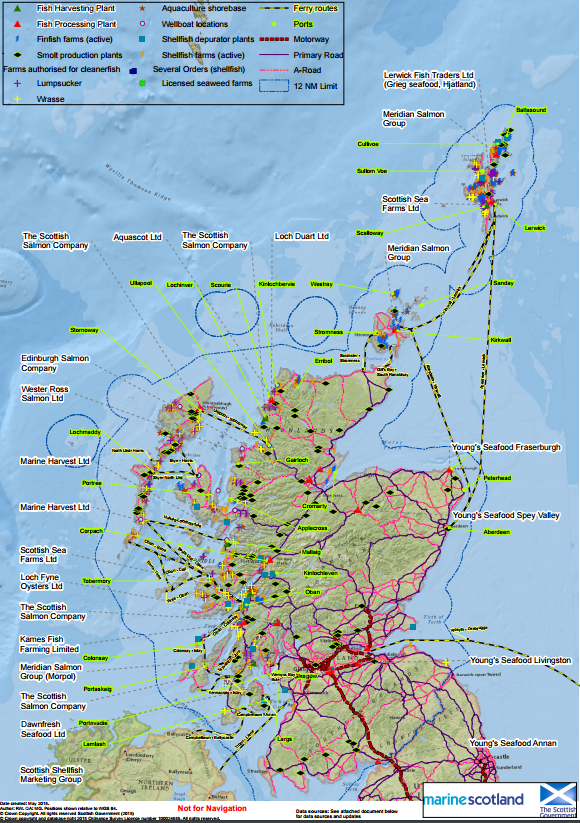
How much farmed Salmon is produced?
The aquaculture industry has set growth targets.
By 2020 the industry aims to increase marine finfish production sustainably to 210,000 tonnes. 162,817 tonnes of salmon were produced in Scotland 2016.
The Scottish Government supports the target as long as it is reached sustainably. Cabinet Secretary for Rural Economy and Connectivity, Fergus Ewing has said that "I am determined to see this [growth] achieved without detriment to our wider environment"(SSPO, 2017). The Ministerial Group for Sustainable Aquaculture (MGSA) was set up to support Scotland’s aquaculture industry to achieve the targets.
In addition to Atlantic salmon, finfish production in Scotland includes rainbow trout (8,096 tonnes), brown trout (41 tonnes) and halibut (67 tonnes).
In 2016 162,817 tonnes of salmon were produced in Scotland - a decrease of 8,905 tonnes (5.2%) on the 2015 total. This was worth £765,239,900 by value in 2016. The figures below shows annual Scottish production of salmon between 2006 and 2016, by weight and value.
By comparison in 2015, according to the OECD, Norway produced 1,303,346 tonnes, Chile produced 608,546 tonnes, and Canada produced 121,926 tonnes of Atlantic salmon.
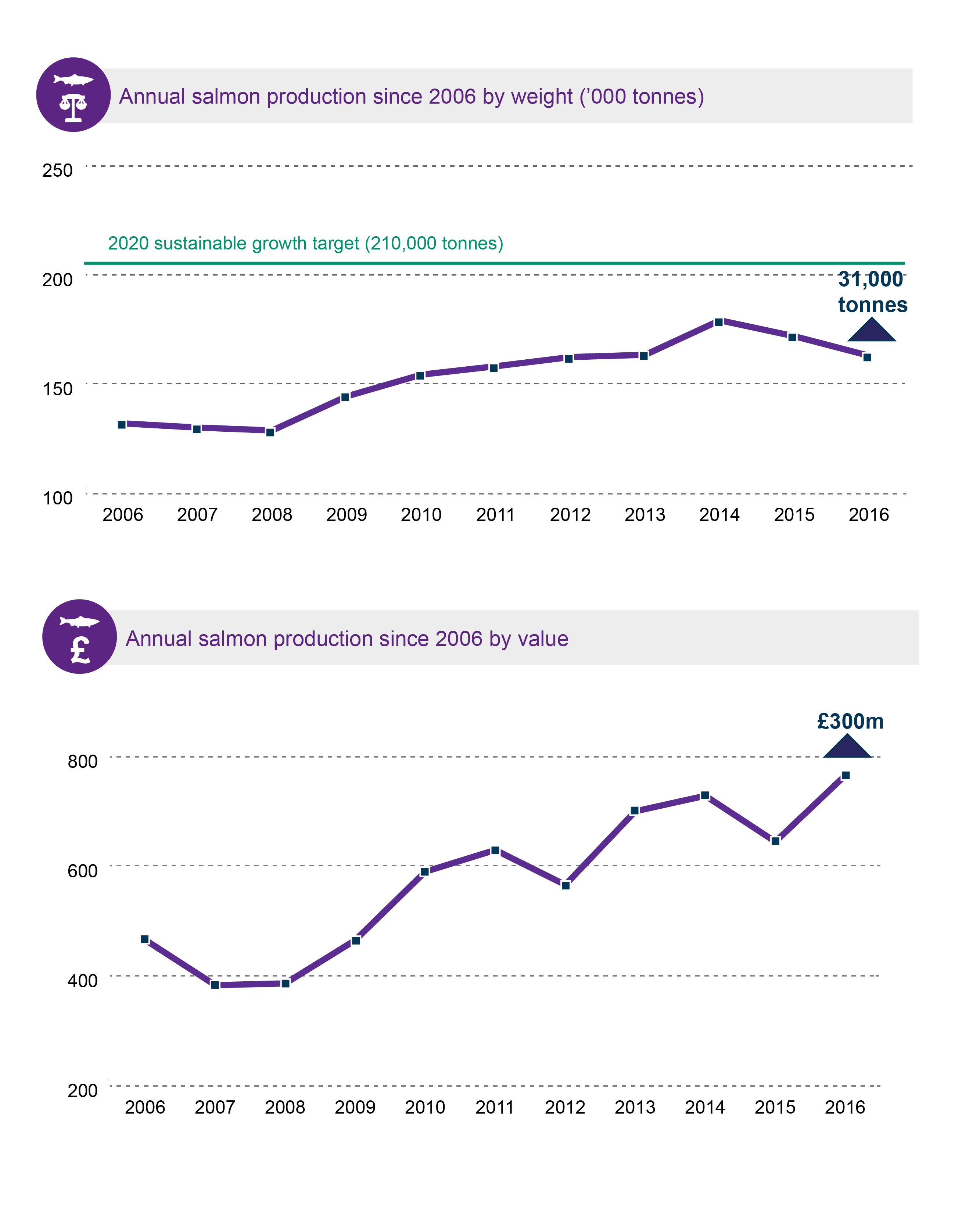
Which companies produce farmed salmon?
Five companies produced 93% of the output in Scotland in 2016. Three of these five largest companies (Marine Harvest, Scottish Sea Farms and Grieg Seafood) are Norwegian owned, the Scottish Salmon Company Ltd is registered in Scotland (with its parent company listed on the Norwegian Stock Exchange), and Cooke Aquaculture has its head office in Canada.
| Company | Tonnes in Gutted Weight Equivalent (GWE) in 2016 |
|---|---|
| Marine Harvest | 45 000 |
| Scottish Seafarms | 28 000 |
| The Scottish Salmon Co. | 24 300 |
| Cooke Aquaculture | 21 000 |
| Grieg Seafood | 13 500 |
| Top 5 | 131 800 |
| Total | 141 700 |
| Top 5 share of total | 93 % |
Source: Marine Harvest, 2017
How much employment is related to farmed salmon?
It has been estimated that the direct, indirect and induced impacts of salmon farming creates 10,340 jobs in Scotland (Highlands and Island Enterprise, 2017).
Jobs in salmon farming production
The figure shows employment over time in salmon farming production in Scotland. In 2016 -
294 staff were involved in smolt production, and
1,486 were involved in salmon production.
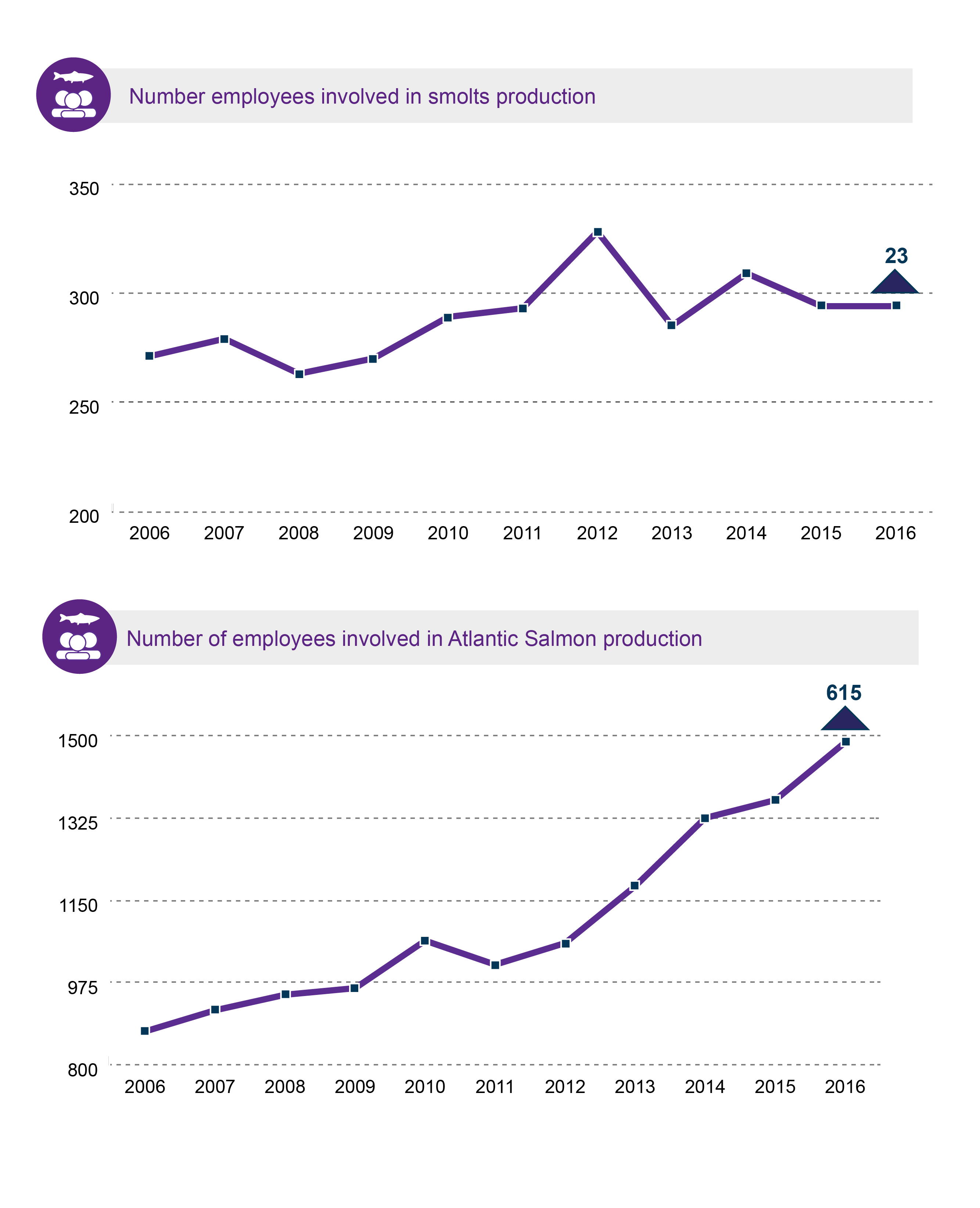
Indirect and induced jobs related to salmon farming
Farm production is only one part of the value chain. Other related jobs include1 -
Suppliers of equipment, transport, feed and husbandry inputs (including bio-tech vaccine and de-licing supply) – the “supply chain”
Organisations involved in research and innovation
Downstream fish processing jobs
Retail and catering sales in Scotland of fish produced in Scotland
“Induced Impacts” – i.e. a grocer, garden centre or electrician may not supply the sector directly, but will benefit from additional income and employment where industry income is spent and re-spent in their local area.
How much Salmon is produced in each region?
Salmon production contributes to the economy in remote rural areas. The map below shows the location of salmon and smolt production sites and the value of salmon production in each Scottish Marine Region.
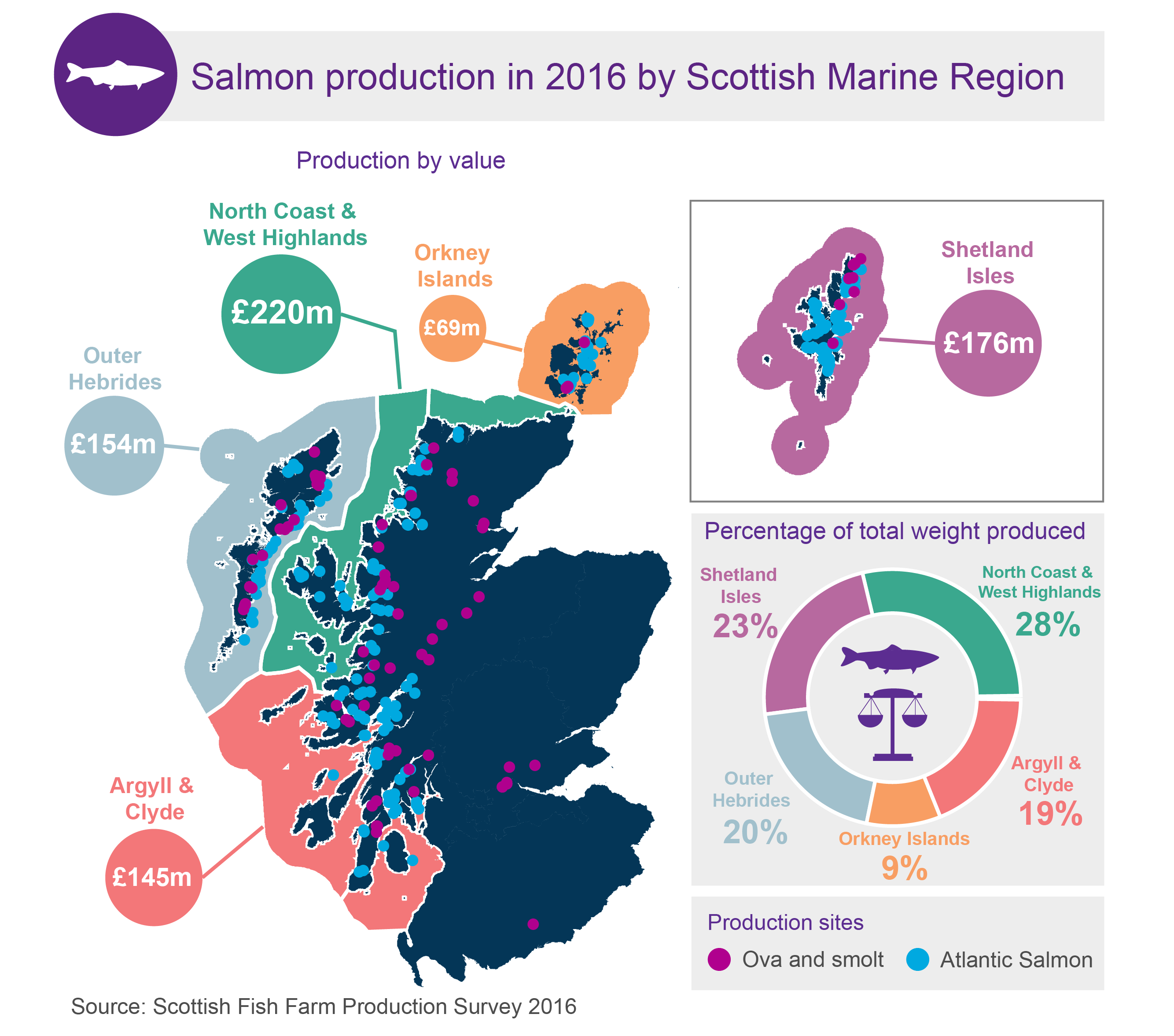
Salmon Imports and Exports
In 2017 £318 million of Scottish farmed salmon was exported to non EU countries and £283 million exported to EU countries - a total of £601 million. The figure below shows exports of salmon from 2012 to 2017. The USA is the largest market while growth in the far east market, where China is the most significant, was strong in 20171 .
The UK also imports salmon. In 2017 the UK imported around £323 million of Atlantic salmon from EU and Non EU countries - the majority from Norway.
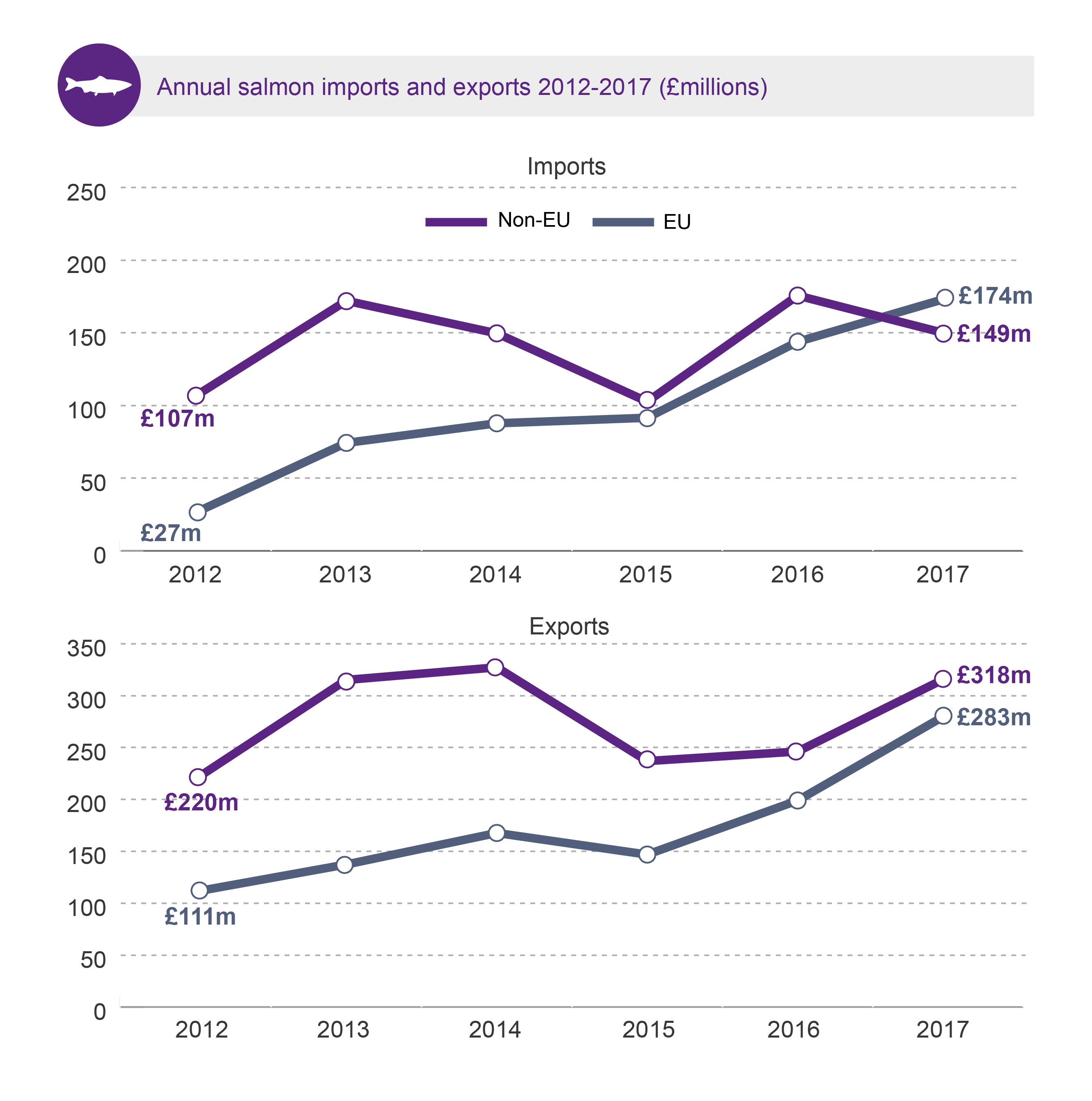
Scotland also imports and exports ova, parr and smolts as part of the farmed salmon production process. The number of ova laid down to hatch in 2016 was 64.3 million, the majority (90.8%) were derived from foreign sources (Scottish Fish Farm Production Survey 2016).
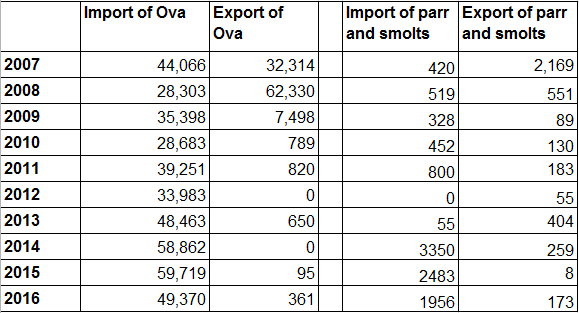
Farmed Salmon Health
Like all farm animals, fish may be susceptible to disease and infestations. Disease control is crucial to the profitable production of any farmed species1. 2Ellis et al (2016) state -
Diseases have affected the Scottish salmon farming industry by reducing harvest through mortality of fish, lost growth (due to stress and inappetance), and early harvest. Lack of confidence in controlling disease has also affected investment, and the costs of controlling disease (manpower for application of chemical sea-lice treatments) can prove significant (Munro and Gauld, 1997). Disease has also been noted to affect ova supplies and employment. ... Effective disease management – via reduced stress in stocks, vaccination, fallowing, area management agreements, biosecurity etc. – is recognised to have been vital to the success of Scottish salmon farming.
The Fish Health Inspectorate provide a list of diseases of wild and farmed finfish. The Scottish Fish Farm Production Survey 2016 states that vaccines are used to provide protection for farmed salmon against the following diseases - furunculosis, infectious pancreatic necrosis (IPN), enteric redmouth (ERM), vibriosis and salmonid alphavirus (SAV).
The majority of farmed fish are vaccinated against furunculosis and IPN, with smaller numbers of fish being vaccinated against ERM, vibriosis and SAV. In 2016 a total of 42.6 million fish were vaccinated across 47 sites. The table below shows vaccinations since 2008.

Marine Scotland Fish Health Inspectorate
Marine Scotland Science Fish Health Inspectorate (MSS-FHI) in Scotland aims to prevent the introduction and spread of listed and emerging fish and shellfish diseases in Scotland. They carry out inspections of fish farms and provide advice and ensure compliance with regulations (see below for more detail). Information relating to the inspection and operational activities of the Fish Health Inspectorate is published on a regular basis.
Fish Mortality
Throughout the 1990s and 2000s there was around 20% mortality of farmed salmon throughout the production cycle. This seems to have increased from 2014 to the present day (Marine Scotland, pers comm, 2017).
There are two sources of farmed salmon mortality data - Scotlands' Aquaculture website and Scottish Fish Farm Production Survey. Improved data will be available in the future. On 12 December 2017, Gilpin Bradley of the SSPO announced that data on sea lice, fish losses and health issues would become available on a farm by farm basis, although no timescale was given1. A similar commitment was also made by David Sandison, General Manager of the Scottish Salmon Producers' Organisation in the Environment, Climate Change and Land Reform Committee meeting on 6 February 2018. The commitment was to publish all data associated with sea lice counts on a farm-by-farm basis, historical data on sea lice on a farm by farm basis, and mortality data.
Scottish Fish Farm Production Survey
The Scottish Fish Farm Production Survey provides information on smolts input and salmon harvest. This shows losses through the production cycle, but only at the end of that cycle. The 2016 survey states "In 2014, the last year for which survival can be calculated, the survival rate from smolt input to harvest decreased to 73.3%." This implies a loss over that production cycle of 26.7%. This loss is not only attributable to mortality. Other reasons for this might be sampling, escapes, and stocks selected for broodstock.
The figure below shows preliminary analysis of the history of losses 1979-2014 (blue circles) with decadal averages (dark blue line), vaccination uptake (green stars) for all vaccines and vaccination specifically for infectious pancreatic necrosis virus (red line), carried out by Marine Scotland (pers comm). The figure above shows that in the 1980s the average losses were 30%. This reduced to 20% in the 1990s, and increased slightly (but not statistically significantly) in the 2000's.
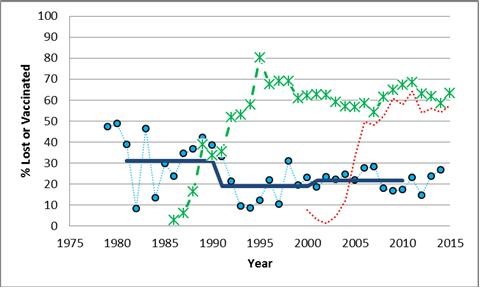
Scotlands' Aquaculture website
Scotlands' Aquaculture website provides Monthly Biomass & Treatment Reports for all fish farms, including a figure for kilograms of biomass lost per month. This shows that mortality was fairly flat at about 1% per month until 2010 and began to increase thereafter. A 1% mortality per month is equivalent to just under 20% mortality over an 18 month production cycle.
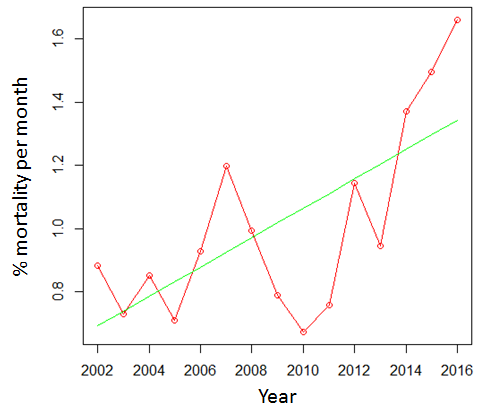
Causes of Mortality
Marine Harvest (2017) provide information on causes of reduced survival in their farms. Marine Harvest also publish sea lice and mortality information on a site by site basis, showing the cause of "incident based mortality".

It may be that mortality is linked to other factors. For example higher sea and air temperature may increase the prevalence of lice and disease, and therefore mortality.
Legislation on Fish Health
Aquatic Animal Health (Scotland) Regulations 2009 - Implementing Council Directive 2006/88/EC
The Aquatic Animal Health (Scotland) Regulations 2009 state that:
Aquaculture Production Businesses (APBs) must be authorised by Marine Scotland Science Fish Health Inspectorate (MSS-FHI) and must meet certain conditions to ensure they remain authorised
low risk installations must be registered. These are installations not placing fish on the market, or put-and-take fisheries not moving stock off site
fish health surveillance will be conducted using a risk-based approach. APBs will be categorised as either high, medium or low risk with respect to the introduction and spread of disease
notifiable diseases list both exotic and non-exotic diseases
an internet-based register of aquaculture production businesses and processing plants is maintained (processing plants will be authorised for the processing of fish or shellfish from an area affected by an exotic or non-exotic disease)
Aquaculture and Fisheries (Scotland) Act 2007
The Aquaculture and Fisheries (Scotland) Act 2007 allows the FHI to assess the risk of an escape of fish from a site and determine that satisfactory measures are in place to contain fish, prevent escapes and recover escaped fish. It also allows inspectors to make an assessment on the level of sea lice on-site and determine whether satisfactory measures are in place for the prevention, control and reduction of sea lice.
The associated legislation The Fish Farming Businesses (Record Keeping) (Scotland) Order 2008 lists and details the records that are required to be kept in order to fulfil the requirements of the Aquaculture and Fisheries (Scotland) Act 2007.
The Aquaculture and Fisheries (Scotland) Act 2013
The Aquaculture and Fisheries (Scotland) Act 2013 amends the 2007 Act so that any persons carrying out the business of fish farming, within a farm management area, is either party to a farm management agreement or prepares and maintains a farm management statement. Any person carrying out the business of fish farming within a farm management area must ensure that the fish farm is managed and operated in accordance with that agreement or statement.
Sea Lice
Leps [sea lice] remains one of the most important health issues for the Scottish salmon aquaculture industry 1
Adult sea lice live on the skin of fish and occur naturally in the marine environment. Sea lice damage their hosts skin through feeding. This can lead to infections by viruses and bacteria. Infestation can cause stress and immune suppression with greater susceptibility to secondary infection and the onset of disease.
Sea Lice Numbers in Scotland
According to Marine Scotland (pers comm, 2018) sea lice numbers peaked in 2015 and have been falling since. Quarterly Fish Health Management Reports based on the SSPO Fish Health Management System shows lice counts on a regional basis. The table below shows the average adult female lice count for each reporting region for 2016.
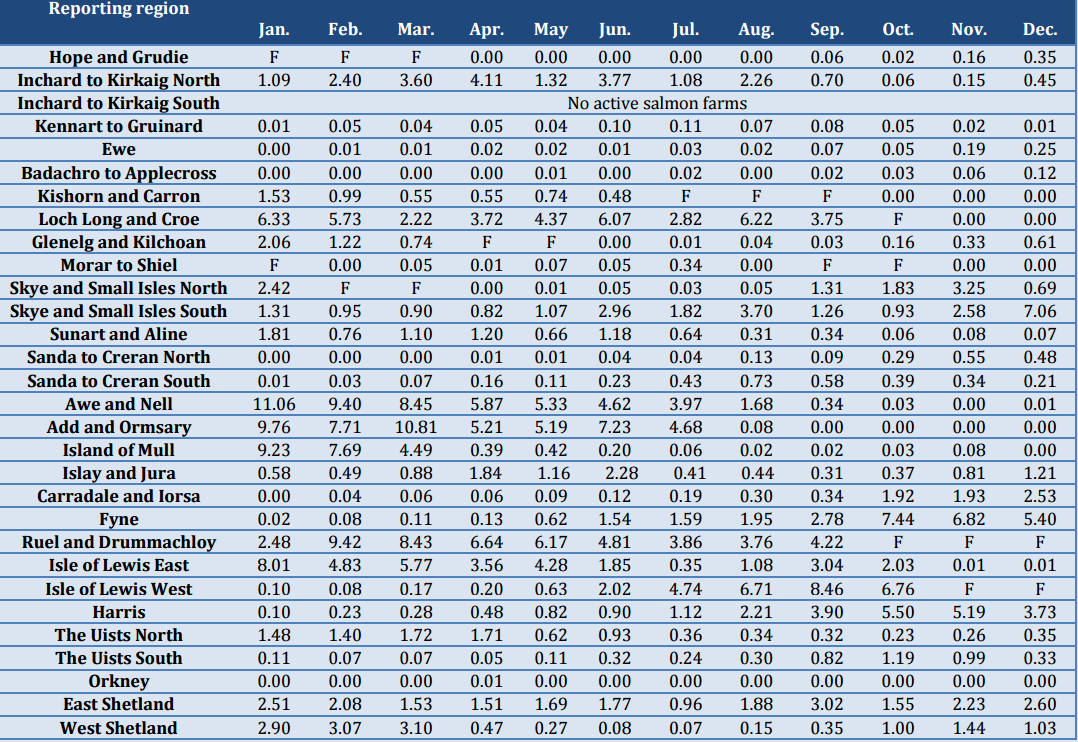
Information on lice counts is not usually in the public domain on a farm by farm basis. However, Marine Harvest Scotland Ltd have been publishing sea lice and mortality information on a site by site basis, in arrears, since April 2017. In September 2017 following a favourable decision from the Information Commissioner, Salmon and Trout Conservation Scotland published information on fish farms that had breached Scottish Government reporting or intervention levels for the numbers of adult female sea lice on the farmed salmon.
Marine Harvest (2017) report that -
15% of sites in Scotland were above national sea lice trigger levels in 2012
10% of sites in Scotland were above national sea lice trigger levels 2013
28% of sites in Scotland were above national sea lice trigger levels in 2014
50% of sites in Scotland were above national sea lice trigger levels in 2015
69% of sites in Scotland were above national sea lice trigger levels in 2016
It seems that "trigger levels" reported against here are the levels at which treatment is suggested in the CoGP (0.5-1 adult female lice).
A commitment to publish all data associated with sea lice counts on a farm-by-farm basis was made by David Sandison, General Manager of the Scottish Salmon Producers' Organisation (SSPO) in the Environment, Climate Change and Land Reform Committee meeting on 6 February 2018. This is a voluntary commitment not a statutory requirement, and would not cover producers who are not members of the SSPO.
Sea lice treatment
In Scotland, the aim is to take an integrated approach to sea lice management1. This means -
co-ordination of farms within defined farm management areas, where fish should be of a single year class, with synchronised fallowing and treatment
strategic control measures implemented at key time periods
the application of medicinal control in a manner which would reduce emergence of parasite resistance
the investigation and introduction of biological and non-biological control methods.
MEDICINAL CONTROL
Medicines used to control sea lice in Scotland are administered as a bath or in feed. Bath treatments are applied using full enclosure, in a tarpaulin, at a marine cage site, or in a wellboat adjacent to the marine cages. The following treatments may be used -
Paramove and Asperix (Trade names): active ingredient is hydrogen peroxide
Salmosan (Trade name): active ingredient is azamethiphos
AMX (Trade name): active ingredient is deltamethrin
The following products are administered in feed -
SLICE (Trade name): active ingredient is emamectin benzoate
Calicide (Trade name): active ingredient is teflubenzuron.
SEPA commissioned review of emamectin benzoate (SLICE)
These products can be harmful to the environment and so their use is controlled. They are also controversial (see for example a report in the Herald - 5th March 2017). In June 2017 SEPA commissioned a review of Environmental Quality Standard for Emamectin Benzoate (SLICE), in fish farms. The review proposed new Environmental Quality Standards (EQSs) for emamectin benzoate. This also proved controversial (see for example an article in the Herald newspaper on 2 July 2017). Subsequently, SEPA has consulted on the review and is conducting an external peer review of the report. The Scottish Government will make a direction to SEPA on the appropriate EQS in due course2.
Fish Health Management Reports
The Fish Health Management Reports produced by the SSPO show the number of treatments for lice using approved veterinary medicines during 3 month reporting periods. For example, in the 3rd quarter of 2017, the number of medicinal treatments for lice ranged from -
no medicinal treatments against lice in Fyne, Hope and Grudie, Sanda to Creran South, and Carradale and Iorsa regions, to
30 medicinal treatments against lice in the Sunart and Aline region.
BIOLOGICAL CONTROL
Wrasse species and lumpsuckers are natural predators of lice and are increasingly being used on farms to control lice. Wrasse and lumpsucker breeding and production is being developed to provide a supply for fish farms.
OTHER METHODS OF CONTROL
Mechanical methods are also used to control lice3.
A thermolicer works by pumping salmon through lukewarm water. Lice have a low tolerance for sudden changes in temperature
A hydrolicer washes lice off the salmon
A fish wash or skamik system uses brushes and water spray to remove lice.
However, as Marine Harvest (2017, p22) note "...new methods generate new challenges, as we experienced at our Greshornish site in Scotland. At Greshornish, we lost 115 283 fish during our first full-scale thermolicer treatment because we lacked experience and failed to fully anticipate the consequences of treating fish compromised by amoebic gill disease with water of up to 34ºC."
Sea Lice Regulation
International agreements
The objective of the North Atlantic Salmon Conservation Organization (NASCO) is to conserve, restore, enhance and rationally manage Atlantic salmon through international cooperation taking account of the best available scientific information. The Williamsburg Resolution agreed to "cooperate in order to minimise adverse effects to the wild salmon stocks from aquaculture, introductions and transfers and transgenics." The EU is party to this convention, but it has no legislative force.
Scottish Regulations
Sea lice are regulated by several key pieces of legislation1 -
The Aquaculture and Fisheries (Scotland) Act 2007 as amended in 2013: allows assessment of sea lice levels on-site and requires that satisfactory measures are in place for the prevention, control and reduction of sea lice
The Aquaculture and Fisheries (Scotland) Act 2013: states that anyone carrying out fish farming must be party to a farm management agreement or maintain a farm management statement
The Fish Farming Businesses (Record Keeping) (Scotland) Order 2008 ensures there are records in relation to staff sea lice training, sea lice records, medicinal records and sea lice responsibility on farm.
Revised Marine Scotland sea lice policy from July 2017
Marine Scotland’s policy on the control of sea lice has changed. It requires that 2-
Fish farms should report to the FHI where an average of 3 adult female sea lice per fish or more is found during a weekly count on any site in Scotland
Where this reporting level is reached, the FHI will increase the monitoring of that site and continue to do so until either the average adult female sea lice count per fish is reduced to below the reporting level of 3, or an intervention limit of an average of 8 adult female sea lice per fish on any fish farming site is reached.
Reaching the reporting level or intervention limit requires the implementation of an explicit action plan, agreed with the FHI. This aims to reduce and maintain the average number of adult female sea lice per fish at the site below the reporting level of 3. If satisfactory measures cannot be demonstrated then enforcement action will be taken.
In the Environment, Climate Change and Land Reform Committee meeting on 6 February 2018, the MSS FHI said that these levels were not based on "pure science" but on (currently) unpublished analysis of SSPO data on industry experience of lice numbers. These trigger levels will be reviewed in July 2018.
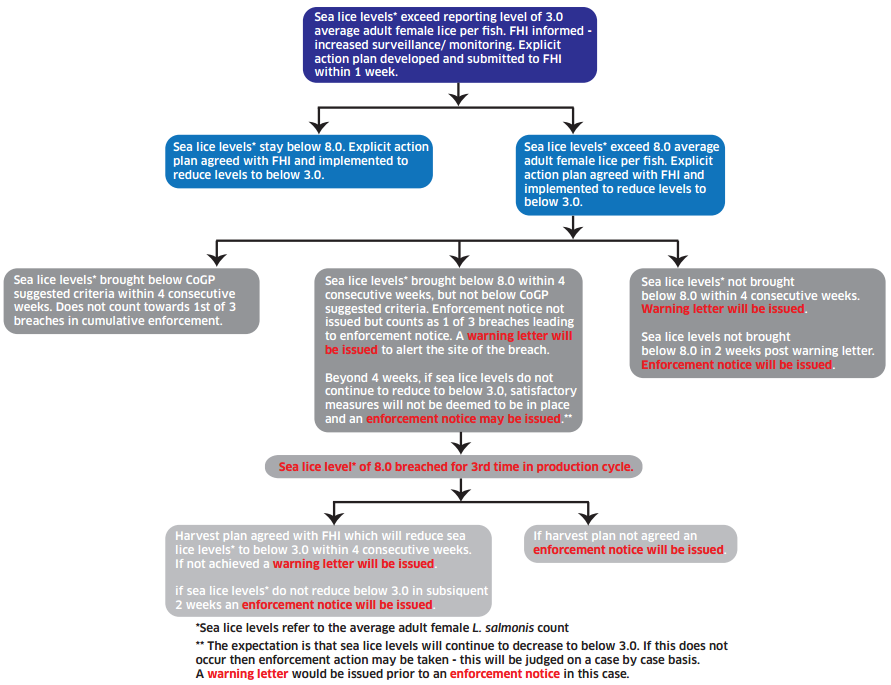
Code of Good Practice (CoGP) for Scottish Finfish Aquaculture
The industry's CoGP3 (chapter 4, p 16) sets out a guide for when salmon should be treated for sea lice. This criteria is different from the criteria used by Marine Scotland set out above.
In general, treatments should be guided by the build-up of pre-adults as indicated by weekly counts, the objective being to prevent the development of gravid females.
Suggested criteria for the treatment of sea lice on individual farm sites are:
An average of 0.5 adult female L. salmonis per fish during the period 1st February to 30th June inclusive.
An average of 1.0 adult female L. salmonis per fish during the period 1st July to 31st January inclusive.
Marine Harvest (2017) however, states that "pens that approach 0.2 adult females should be treated".
The CoGP also includes the National Treatment Strategy (NTS) for the Control of Sea Lice on Scottish Salmon Farms which is an industry strategy which defines approaches to lice management. All salmon farming companies within SSPO adopt these procedures.
The Regulatory Regime in Scotland
Like every other sector, salmon farming must comply with a range of legislation, each with its own purpose. Annex 8 of the industry code of good practice for finfish aquaculture1 details relevant legislation -
Food legislation related to food safety, food traceability, and food hygiene.
Feed legislation. Farmers, including salmon farmers, have to follow basic hygiene procedures in relation to the feed they use or grow and must ensure that hazards are properly assessed and risks are controlled.
Fish health legislation includes instruments to: authorise aquaculture production businesses (APBs) and requires disease prevention measures to be taken; allow inspection of fish farms; require the maintenance and retention of records on the prevention, control and reduction of parasites and escapes; disposal of fish that have died.
Environmental legislation includes international conventions such as Convention for the Conservation of Salmon in the North Atlantic
Planning related regulation - including planning regulations and environment impact assessment regulations
Environmental protection legislation - including the Aquaculture and Fisheries (Scotland) Act 2013 which aims to ensure that the interaction between farmed and wild fisheries are managed; EU rules on the sustainable use of pesticides; the Environmental Protection Act 1990 which relates to the production and disposal of waste; the Water Environment and Water Services (Scotland) Act 2003 which gives Ministers powers to introduce regulatory controls over water activities in order to protect, improve and promote sustainable use of Scotland’s water environment, and the Water Environment (Controlled Activities Regulations) (Scotland) 2011 (CAR) under which SEPA may authorise the carrying on of a controlled activity and impose conditions necessary for the protection of the water environment.
Conservation legislation - including Aquaculture and Fisheries (Scotland) Act 2007 which relates to the control of parasites, the containment of, prevention of escape of, and recovery of escaped fish. Conservation (Natural Habitats, &c.) (Scotland) Regulations 1994 (as amended) (SSI 1994 No 2716) transposed the Habitats Directive and the (Birds Directive) into Scottish law.
Framework legislation - including Environmental Liability (Scotland) Regulations 2009 to the prevention and remedying of environmental damage; and the Marine (Scotland) Act 2010 which introduced a framework for the sustainable management of the seas around Scotland.
Aquaculture and Fisheries (Scotland) Act 2013
The most recent legislation relating to salmon farming in Scotland is the Aquaculture and Fisheries (Scotland) Act 2013. This states that all fish farms must be party to a farm management agreement/statement to agree arrangements for –
Fish health management
Management of parasites
Movement of fish
Harvesting and fallowing of fish
It enables regulations setting technical requirements for equipment used in fish farming in relation to –
the containment of fish
the prevention of escape of fish
the prevention, control or reduction of parasites, pathogens or diseases.
The Salmon Farm Consenting Process
To set up a salmon farm in Scotland, a developer needs consent from the local authority, Marine Scotland, the Crown Estate and the Scottish Environment Protection Agency (SEPA).
Taken from the Independent Review of Scottish Aquaculture Consenting1 (2016) the figure below summarises the current consenting process for salmon farming in Scotland.
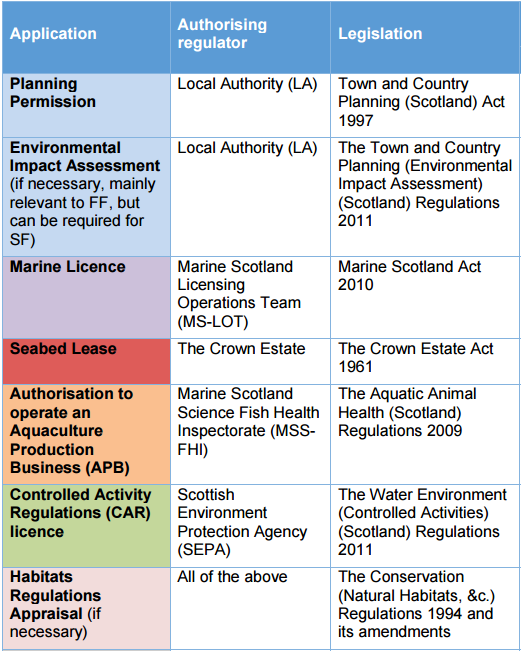
Crown Estate Licences
Crown Esate Scotland currently has a statutory duty to obtain a return for any area of seabed or foreshore within Crown ownership that is used for commercial purposes, with due regard to the requirements of good management. Aquaculture operators therefore require a seabed (or foreshore) lease from the Crown Estate. This means the Crown Estate has a role at the beginning and the end of the fish farm development process1 -
When businesses want to explore areas for potential development they may apply to the Crown Estate for a Lease Option Agreement (LOA). This secures the area of seabed, while planning permission and other licences are sought.
Once all relevant consent and licences have been granted for the site, the Crown Estate will then grant a seabed lease.
Planning Permission
Under section 26(6) of the Town and Country Planning (Scotland) Act 1997 fish farming is considered a development and requires permission1. Fish farming developments (out to 12 nm) are under the jurisdiction of the Town and Country Planning (Marine Fish Farming) (Scotland) Order 2007. Planning permission is obtained from the local authority.
Scotland’s National Marine Plan (Chapter 8) introduced the issue of wild salmon into the Planning Permission decision making process, as well as within the EIA process. It states -
WILD FISH 1: The impact of development and use of the marine environment on diadromous fish species should be considered in marine planning and decision making processes. Where evidence of impacts on salmon and other diadromous species is inconclusive, mitigation should be adopted where possible and information on impacts on diadromous species from monitoring of developments should be used to inform subsequent marine decision making.
Local Authorities may ask that Environmental Management Plans be developed and implemented as part of a condition of consent. Monitoring of farmed fish is essential and integral to an effective EMP. In addition to EMPs, the LAs may grant temporary planning permission (e.g. for 10 years). This may allow a mechanism for action if sea lice issues and/or unacceptable interactions with wild salmonids occur2.
In relation to the interaction between farmed fish and conservation of wild fish, Fisheries Management Scotland have said that under the Nature Conservation (Scotland) Act (2004), all public bodies in Scotland are required to further the conservation of biodiversity when carrying out their responsibilities. In evidence to the ECCLR committee on 6 February, Mark Harvey, Planning Team Leader, Highland Council, said that the biodiversity duty was very much in the planning authorities minds when considering planning permission.
Environmental Impact Assessment (EIA)
The Town and Country Planning (Environmental Impact Assessment) (Scotland) Regulations 2011 implement the European Council Directives (85/337/EEC and 97/11/EC as amended) on the assessment of the effects of certain public and private projects on the environment.
Under the 2011 Regulations, an EIA must be undertaken where any proposed finfish aquaculture development 1-
is to be carried out in a sensitive area
is designed to hold a biomass of ≥100 tonnes
will extend ≥0.1 hectare surface area of marine waters, including any proposed structures or excavations, or
the installation resulting from the development is designed to produce more than 10 tonnes of dead fish weight per year.
It is up to the developer to compile the Environmental Statement, which will accompany the planning permission application to the local authority.
In the Environment Climate Change and Land Reform Committee on 6 February, Mark Harvey, Planning Team Leader, Highland Council said that the Environmental Statements include a short section on disposal of mortalities.
Controlled Activity Regulations (CAR)
The Water Environment (Controlled Activities) (Scotland) Regulations 2011 require any prospective fish farm operator to apply to SEPA for a licence. Conditions in the licence are set to protect the water environment by placing limits on the amount of fish that can be held in the cages and the type and amount of medicines and chemicals that can be used on a particular site1.
CAR licence applications are supported by survey information undertaken by the aquaculture business on the physical, chemical and biological condition of the seabed and water column. The statutory timeline for consenting is 16 weeks from an application.
SEPA can take enforcement action if operators fail to comply with conditions of their CAR licence or if sites are not meeting SEPA standards on an ongoing basis. SEPA state that -
Aquaculture is ... one of the least compliant sectors regulated by SEPA. Around 21% of marine finfish farms and 7% of freshwater finfish farms were not compliant in 2015. Non-compliance was mainly due to unsatisfactory seabed surveys, exceedance of biomass or discharge limits, and effluent quality failures. This poor compliance performance must change.
SEPA also has the power to vary or revoke an authorisation if compliance does not improve or if there is evidence that the water environment and its ecology have been harmed. In the Environment Climate Change and Land Reform Committee on 6 February, Anne Anderson from SEPA said that she was not aware of any authorisation ever being revoked.
Marine Licences
Marine Scotland Licensing Team (MS-LOT) is responsible for 2 licences for salmon farms -
a licence for equipment (such as fish farm cages, walkways/pontoons) and moorings (i.e. deposits on the seabed) which may be a hazard to navigation
a separate licence for ‘discharge of treatment agents’ from a wellboat1.
A wellboat is a vessel that moves live and dead fish outwith a fish farm site. They are used for transportation of live fish, grading, treatment and taking fish to processing.
There are no statutory timelines for marine licensing, however MS-LOT have a target time frame of 14 weeks for licence determination.
Authorisation to operate an Aquaculture Production Business (APB)
Finfish farm businesses require authorisation to operate an Aquaculture Production Business (APB) from the MSS - FHI1. This relates to animal health requirements and the prevention and control of certain diseases in aquatic animals. Authorisation, subject to conditions, is granted where the operation of the business will not lead to an unacceptable risk of spreading disease.
It is the business, rather than a site that is authorised. The APB authorisation includes details of each site that will be operated by the business, and these details are listed on a public register. Scotland's register can be found here.
APB authorisations are rarely refused, but conditions may be imposed. Authorisations can be suspended or revoked if a company is not complying with conditions or requirements as per the Aquatic Animal Health (Scotland) Regulations 2009.
APBs must establish, maintain and comply with a Biosecurity Measures Plan (BMP). This must include -
The manner and frequency in which mortalities will be removed, recorded and safely disposed
The manner and period in which the APB will notify the Scottish Ministers or a veterinary professional of any increased or unexplained mortalities in aquaculture animals held on each farm site
The actions that will be taken by the APB in the event that the presence or suspicion of the presence of any listed disease is detected and how and when that will be notified to the Scottish Ministers
The measures that are in place at the farm site to maintain the physical containment of the aquaculture animals held on the farm site.
Habitats Regulations Appraisal (HRA)
The Conservation (Natural Habitats, etc.) Regulations 1994 require competent authorities to carry out an appropriate assessment (AA) of a plan if it is likely to have a significant effect on a Natura site - this is known as a Habitats Regulations Appraisal1.
A competent authority must not authorise a plan unless the appropriate assessment means it will not adversely affect the integrity of a Natura site. The only exception is if there are no alternative solutions, and there are imperative reasons of overriding public interest for the plan or project to go ahead.
For a fish farm the local authority may carry out an HRA in relation to planning permission; Marine Scotland may carry out an HRA in relation to a marine licence; and SEPA may carry out an HRA in relation to a CAR licence etc1.
Overview of consenting processes
The figure below shows how the different consenting processes work together in the development of a salmon farm. It may take 112 weeks for full consent for a new fish farm to be obtained1. The Independent Review of Scottish Aquaculture Consenting report highlights opportunities for "quick wins that are comparatively simple and could be implemented quickly to improve existing arrangements... these process improvements would reduce the overall time taken to achieve consent by at least 30 weeks...this would lead to consent within 52 weeks"(p 69).
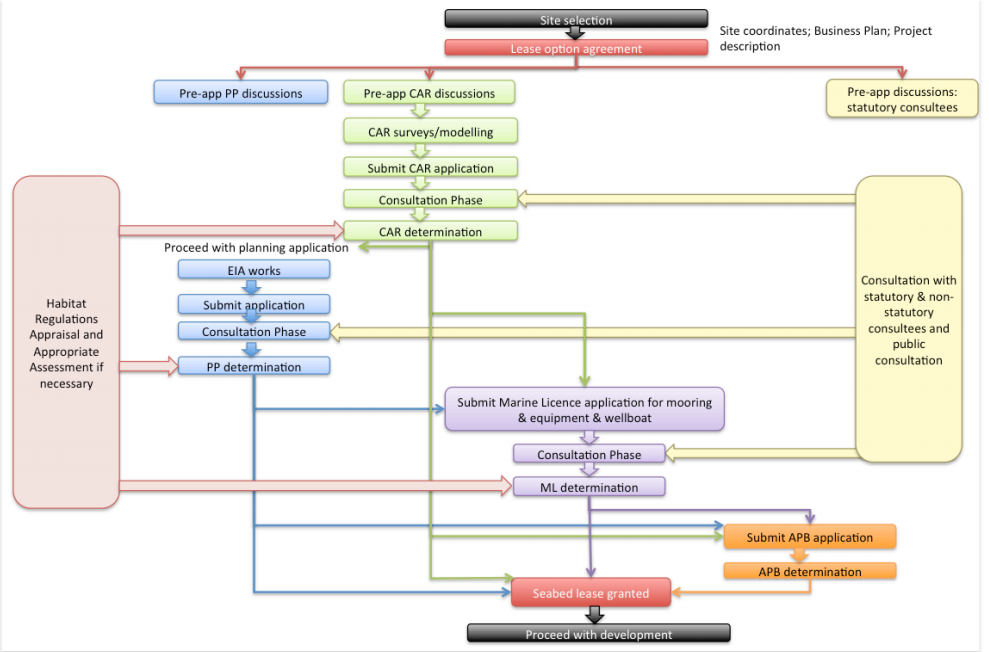
Ongoing Monitoring and Inspection of Fish Farms
Fish farms are subject to ongong monitoring and inspections, in addition to initial consenting requirements.
Crown Estate seabed lease. The Crown estate is not a regulator and has no statutory function in relation to fish farming. However, rents for fish farms are reviewed every five years by an independent expert. Aquaculture charges depend on net gutted weight for finfish. The current charge for salmon is £27.50 per tonne. Outer Isles farms (Outer Hebrides, Orkney and Shetland) receive a 10% reduction to reflect their higher costs1.
Local Authorities for food production - Inspections of farms producing fish for human consumption are carried out by local authorities according to the Food Law Code of Practice (Scotland) under the food establishment rating scheme which determines inspection frequency based on risk.
SEPA under the Controlled Activities Regulation - Salmon farms are inspected, usually twice a year, by SEPA under CAR. Such inspections will typically involve an inspection of the cage site and/or potentially any associated shore base plus an inspection of records held at the operating company offices2.
The CAR licence also requires that a seabed monitoring survey is carried out by the operator during each production cycle and submitted to SEPA for evaluation3. SEPA carries out audit work related to seabed monitoring on 5 to 15 sites annually.
Pollution discharge - Fish farmers also make regular data returns to SEPA detailing the scale of the discharges from each of their farms. Most of this data is contained within the Scotland’s Aquaculture website.
Fish Health Inspectorate monitoring of Aquaculture Production Businesses - Ongoing monitoring and inspection of fish health is undertaken by the MSS - FHI using a risk-based approach. Scotland’s health status and the site risk rank determines the surveillance frequency of inspections. Inspections range in frequency from once a year, to at least every third year. There is an annual total of around 251 site inspections each year.
This surveillance frequency does not relate to sea lice levels, the potential risk of escapes or presence of non-listed diseases, however because of their importance and potential effects, they are included in the passive site surveillance programme4.
Information and results relating to MSS - FHI inspections are published quarterly.
Salmon Farming in Scotland to 2030
A number of recent reports suggest priorities, recommendations, and actions for the future of salmon farming in Scotland. These include -
Aquaculture Growth to 2030 - a strategic plan for farming Scotland's seas, by Scotland Food & Drink. It is the result of a "working group of leading aquaculture businesses and organisations [who] came together to create a growth strategy for aquaculture in Scotland to 2030."1 It suggests a number of strategic priorities and recommendations.
Scottish aquaculture: a view towards 2030 is "an innovation roadmap and sector needs study" conducted on behalf of the Scottish Aquaculture Innovation Centre and Highlands and Islands Enterprise. It suggests steps needed to move the industry forward2.
The value of aquaculture to Scotland is a report for Highlands and Islands Enterprise and Marine Scotland. Section 8 considers actions that would assist the industry to maximise impacts to 2030.3
Recent Scottish Government and Regulator action
In the last few years a number of actions have been taken by Scottish Government and regulators in relation to the salmon farming sector:
The National Marine Plan (Chapter 7) (2015) sets out objectives and planning policies related to aquaculture
The Scottish Government commissioned the Independent Review of Scottish Aquaculture Consenting in 2016, which includes recommendations on how the consenting regime might change
SEPA consulted on Depositional Zone Regulation (DZR) proposals in September 2017. This is about a change to the way SEPA licences control the amount of waste a fish farm can release.
SEPA commissioned a Review of the Emamectin Benzoate Marine Sediment Environmental Quality Standards. Work in this area continues and SEPA published a Revised Interim Regulatory Position Statement in October 2017.
The Strategic Farmed Fish Health Framework Working Group was established in December 2017 to deliver a farmed fish health framework for Scotland. The group will produce a high-level farmed fish health framework by spring 2018.
SEPA expects to consult on its Sector Plan for finfish aquaculture in early 2018. "This plan will set out how the Agency proposes to work with operators to ensure full regulatory compliance and help operators go beyond compliance to achieve environmental excellence."